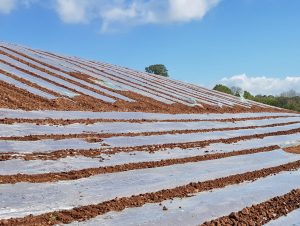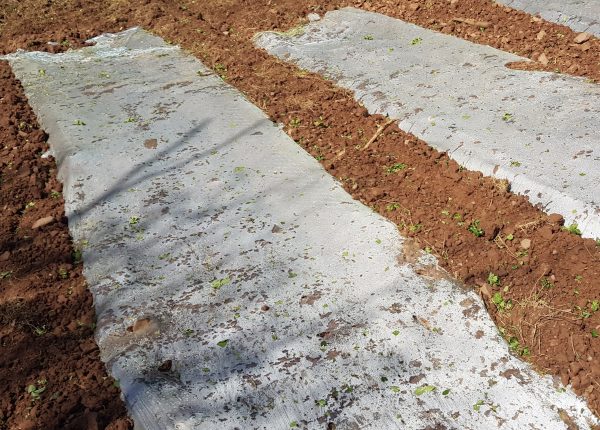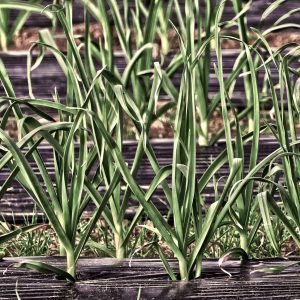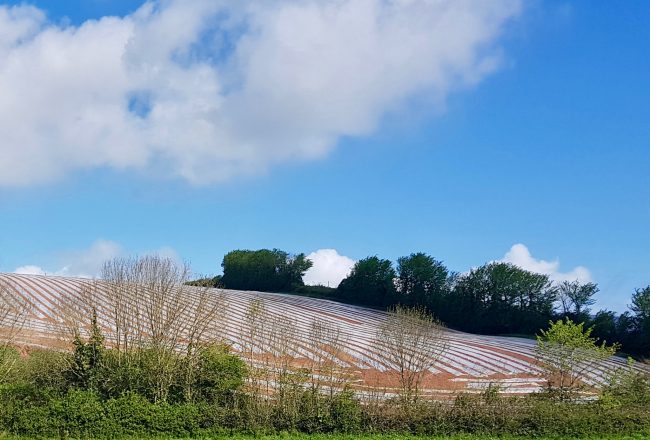Plastics, pollution and soil

Plastic mulch - white (though sometimes black) polyethylene strips, each about a meter wide, can occasionally be seen stretching across fields. Crops grow through the slits or holes in the thin plastic sheeting. The sheets are used because they help to
- conserve water,
- suppress weeds,
- reduce soil compaction
- boost soil temperatures
- reduce waste - by keeping ripening fruit off the soil
 The use of plastic “mulch” to grow crops was suggested by Dr Emery Emmert (University of Kentucky) - who also advocated the use of polythene high tunnels (polytunnels) instead of glass greenhouses.
The use of plastic “mulch” to grow crops was suggested by Dr Emery Emmert (University of Kentucky) - who also advocated the use of polythene high tunnels (polytunnels) instead of glass greenhouses.
Extensive use of is made of such sheets in some parts of the world. The used sheets can be a problem as they are expensive to collect, discard or recycle, sometimes they are left on the fields or illegally dumped or burnt. Even when the sheets are carefully disposed off (the thin plastic readily tears), small fragments remain in the soil. If plastic mulch is used year after year, the soil accumulates plastic residues, which change the physical and chemical properties of the soil.
The effects of plastic pollution in soil are largely unknown. The majority of research into plastic pollution has focused on aquatic systems. Even back in the 1960s, dead seabirds were found to have stomachs full of plastic. In the late 90’s, the Great Pacific Garbage Patch was described and Sir David Attenborough has graphically described the effects of plastics in his series Blue Planet 11.

Recently, attention has focused on the physical breakdown of plastic products, resulting in microplastics and nanoplastics. Whilst these minute particles result from the breakdown of plastic items, they are also introduced into the environment from the use of personal-care products, paints, industrial abrasives etc. Nanoplastics have been found in the internal organs of a wide range of marine organisms and evidence is emerging that these plastic particles release chemicals that affect the physiology, reproduction, development, and behaviour of these organisms.
The amount of nano-plastics and micro-plastics in soils is not really known but agricultural / farmland may be at significant risk. Even when plastic mulching is not used, sewage sludge may be used as fertilizer - and this contains nanoplastics. Also, treated wastewater is used for irrigation purposes and this again a source of plastic.
 Research into plastics in soils is only now starting, but nearly a half century of plastic mulching has provided some insights into the soil’s plastic burden. It is known that mass of micro-organisms in the soil and the soil's overall metabolic activity decreased with increasing plastic mulch residues . The variety of micro-organisms (as measured by their use of different carbon sources) was also reduced. It has also been shown that earthworms in microplastic ‘enriched’ plant litter grew more slowly and had a shorter life span, and there is also evidence that the gut of earthworms becomes inflamed after exposure to microplastics. Earthworms have a role in aerating the soil and transporting materials such as dead leaves from the surface to deeper in the soil, they also 'inadvertently' transport micro-plastics. Springtails, a group of soil micro-arthropods (Collembola) can also help move micro-plastics in the soil. The movement of microplastics through the soil makes these materials ‘accessible’ to other soil dwellers but it is not clear if they pass along food chains (as do pesticides). Whether nano-plastics are taken up by or affect plants - again is not clear. However, the chemicals released by plastics such as phthalates may taken up by plants. One survey of different vegetables grown in plastic mulch has recorded the presence of phthalates in the crop.
Research into plastics in soils is only now starting, but nearly a half century of plastic mulching has provided some insights into the soil’s plastic burden. It is known that mass of micro-organisms in the soil and the soil's overall metabolic activity decreased with increasing plastic mulch residues . The variety of micro-organisms (as measured by their use of different carbon sources) was also reduced. It has also been shown that earthworms in microplastic ‘enriched’ plant litter grew more slowly and had a shorter life span, and there is also evidence that the gut of earthworms becomes inflamed after exposure to microplastics. Earthworms have a role in aerating the soil and transporting materials such as dead leaves from the surface to deeper in the soil, they also 'inadvertently' transport micro-plastics. Springtails, a group of soil micro-arthropods (Collembola) can also help move micro-plastics in the soil. The movement of microplastics through the soil makes these materials ‘accessible’ to other soil dwellers but it is not clear if they pass along food chains (as do pesticides). Whether nano-plastics are taken up by or affect plants - again is not clear. However, the chemicals released by plastics such as phthalates may taken up by plants. One survey of different vegetables grown in plastic mulch has recorded the presence of phthalates in the crop.
What is clear is that micro-plastics and nano-plastics will be around for a long, long time. The durability of plastic, the characteristic that has made plastic so useful to us, is a two-edged sword. The lifetime of plastics in soils may well range from decades to centuries, so microplastics will continue to accumulate in soil and water.

[Thanks to Stuart for images of fields with white plastic strips.
Black plastic mulch above right : Image by Wolfgang Eckert from Pixabay]
Comments are closed for this post.
